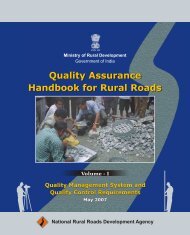Grameen Sampark Final April 0... - pmgsy
Grameen Sampark Final April 0... - pmgsy
Grameen Sampark Final April 0... - pmgsy
Create successful ePaper yourself
Turn your PDF publications into a flip-book with our unique Google optimized e-Paper software.
26<br />
Increase in the C.B.R. value is due to compaction<br />
characteristics of polypropylene fibre reinforced soil.<br />
Higher compaction can be achieved by addition of<br />
fibres with higher aspect ratio up to certain limit. The<br />
design of flexible pavement is governed by C.B.R. value<br />
of subgrade soil. Thus, higher value of C.B.R. for<br />
subgrade soil gives lesser pavement thickness and<br />
proves to be the economical solution in pavement<br />
construction.<br />
% Soaked CBR Value<br />
5.5<br />
5<br />
4.5<br />
4<br />
3.5<br />
3<br />
0 1 2 3<br />
Polypropylene fibres Content<br />
Figure 1: Relationship between polypropylene fibres<br />
content and Soaked % C.B.R. value<br />
<strong>Grameen</strong> <strong>Sampark</strong><br />
1 % fibres 2 % fibres 3 % fibres<br />
Reduction in Crust Thickness of Flexible<br />
Pavement<br />
Thickness of flexible pavement is calculated based on<br />
C.B.R. value of soil subgrade and traffic in terms of ESAL<br />
applications as per SP:72-2007. As the C.B.R. value<br />
increased from 3.05 % to 5.35 %, on addition of 2 %<br />
polypropylene fibres with aspect ratio of 40, the crust<br />
thickness reduces appreciably. Table 5 below, illustrates<br />
the reduction in crust thickness for different ESAL<br />
applications (Traffic categories T4 to T 7of SP 72:2007)<br />
From table 5, it is observed that the design crust<br />
thickness reduces by 75 mm for traffic category T4 and<br />
by 100 mm for traffic categories T5 to T7. The reduction<br />
in crust thickness is partly in the thickness of modified<br />
soil with C.B.R. more than 10 % and partly in the<br />
thickness of granular sub base (GSB).<br />
Conclusions<br />
Based on the limited experimental work done in the<br />
laboratory, following conclusions are drawn:<br />
1. On addition of 2 % polypropylene fibres with<br />
aspect ratio of 40, the soaked C.B.R value can be<br />
improved up to 75 % in comparison with the unreinforced<br />
soil.<br />
2. The crust thickness is reduced by 75 to 100 mm for<br />
different ESAL applications.<br />
References<br />
1. Boominathan A. (1999), “Randomly Distributed<br />
fibre Reinforced Sand”, Short term course on<br />
Geosynthetics and reinforced soil structure,<br />
I.I.T.Madras, India, pp. XVI 1 to XVI 1<strong>0.</strong><br />
2. Meenal Gosavi, K.A.Patil, S.Mittal (2004) Swami<br />
Saran “Improvement of Properties of Soil in<br />
Subgrade by Using Synthetic Reinforcement”<br />
Journal of Institution of Engineers (India), CV, Vol.<br />
84, pp.257-262, February 2004<br />
3. Ranjan Gopal and Charan H.D. (1998) “Randomly<br />
Distributed fibre Reinforced Soil”, IE (I) Journal,<br />
Vol.79, pp. 91-100 .<br />
Table 5: Reduction in Crust Thickness with increase in CBR value<br />
Sr. CBR 1 to 2 Lakhs 2 to 3 Lakhs 3 to 6 Lakhs 6 to 10 Lakhs<br />
No. ESAL (T4 ) ESAL (T5 ) ESAL (T6) ESAL (T7)<br />
1. 3.05 % 375 mm 425 mm 475 mm 525 mm<br />
2. 5.35 % 300 mm 325 mm 375 mm 425 mm

















